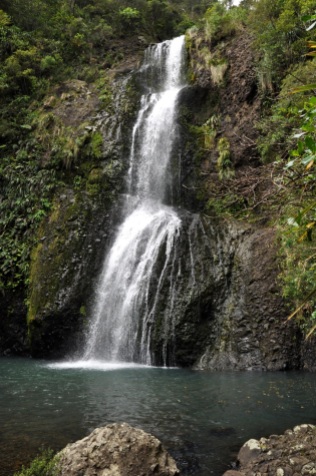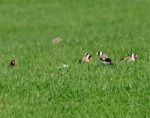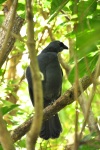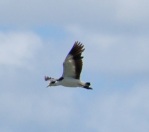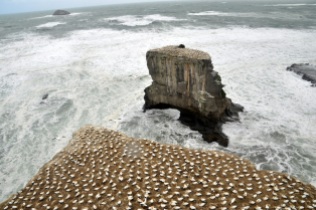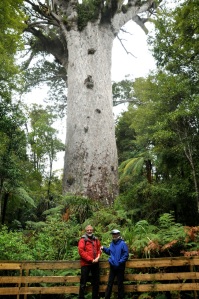I wanted to climb one of the small mountains on a headlands, and Whangarei Head looked like a good place. Besides, the area has some wineries worth visiting (our version of multi-tasking). We found a good-looking B&B on the internet, but y’know, those sites often don’t give you the full story, as we have discovered quite a few times. The surprise with this B&B was getting to it; we had to travel on a narrow, twisty, steep, cliff-edge, white-knuckled road, much to Ginger’s dismay. Even then, the gravel, rutted, pot-holed up-and-down driveway to the B&B was a challenge. Once we arrived at the B&B it was quite pleasant, and certainly quiet! However, the specter of doing that drive twice a day was a bit daunting – and going out for dinner meant returning at night.  This travel stuff is always exciting, requiring a certain amount of stiff-upper-lip fortitude, and maybe a good sense of humor. The picture is the view from the B&B’s back yard (notice we’re high up?). The peak with the jiggles on top, just left of center, is the one I’m going to climb tomorrow – Mt. Manaia.
This travel stuff is always exciting, requiring a certain amount of stiff-upper-lip fortitude, and maybe a good sense of humor. The picture is the view from the B&B’s back yard (notice we’re high up?). The peak with the jiggles on top, just left of center, is the one I’m going to climb tomorrow – Mt. Manaia.

Ginger, bless her heart, has decided to accompany me on the mountain climb, but we miss the trailhead turnoff and end up at Ocean Beach on the other side of the little peninsula (I realize we’re on the wrong road, but there’s no easy way to turn around on the narrow road, and besides we’re exploring). Not a bad little beach, eh? They’re a dime a dozen, and at least for this time of year they’re lonely, looking for love. But we have hiking to do, so back we go. Between us and Mt. Mania is a promontory, Busby Head and Smuggler’s Cove,  reputed to be scenic, so we decide to hike here first. That little chunk of land with a hill on it, protruding into the bay, is where we’re hiking.
reputed to be scenic, so we decide to hike here first. That little chunk of land with a hill on it, protruding into the bay, is where we’re hiking.
It’s a nice, sunny day – rare for us! And the hike is very pleasant, with lots of birds to see. Swallows zipping by on the ocean breezes, impossible to photograph – they’re haulin’. I’ll show you some birds I did manage to catch a bit later. Pictures of the hike follow.
Here are the birds, or at least some of them. Some you’ve seen already – Pukeko and Tui are everywhere, but I don’t need to show them again. Others I haven’t identified yet, but hey, there’s enough here to keep you entertained, yes?
-

-
Yellowhammer
-

-
Paradise Shelduck
-

-
NZ Pidgeon
-

-
NZ Kingfisher
-

-
Indian Myna
-

-
Goldfinch
So now on to Mt. Manaia! On, on! I have twisted my ankle on Busby Head by stepping into a hole while walking off trail beside Ginger, but I will not be deterred! It’s the same ankle that I sprained in Brussels, where I walked miles on it every day, and it was just now getting better (it takes longer to heal at this age, I note). The trail marker says the hike is very steep and will take 2 hours round trip, and Ginger decides she has had enough hiking and that only an idiot would do that climb with a sprained ankle. Yep, she is right. The trail doesn’t start out that steep. I meet a couple of people coming down the trail, but it’s late afternoon and I am all alone now. It’s a pretty trail, and it is increasingly steep.  The Dept of Conservation (DOC) here is amazing. The parks and hiking trails and bird sanctuaries and mammal pest removal programs are everywhere and done very very well. I wish we had trails like these at home!!! They’re gorgeous, well-maintained, I could say perfect. On this hike they have installed what seems like a million wood stairs going up this steep mountain. A little wierd; I came here to hike, not climb no stinkin’ stairs! But then I get it. Brilliant! The switchbacks that we would have had in the US would have made this hike about 3 times as long, with all the erosion problems inherent in switchbacks. These stairs have a water channel on one side leading to pipes going under the trail. Impressive.
The Dept of Conservation (DOC) here is amazing. The parks and hiking trails and bird sanctuaries and mammal pest removal programs are everywhere and done very very well. I wish we had trails like these at home!!! They’re gorgeous, well-maintained, I could say perfect. On this hike they have installed what seems like a million wood stairs going up this steep mountain. A little wierd; I came here to hike, not climb no stinkin’ stairs! But then I get it. Brilliant! The switchbacks that we would have had in the US would have made this hike about 3 times as long, with all the erosion problems inherent in switchbacks. These stairs have a water channel on one side leading to pipes going under the trail. Impressive.
More pictures of the trail, above. That tree in the middle is a kauri, growing all by itself. The last image shows 3 stair sections going up, the last one maybe lost in the sunlight, top of image, center. The trail is steep!
Finally the last scramble up some rocks. Views from the top are a little disappointing; the
view is NOT 360. There are vertical stone outcroppings that block the view front and back (those “jiggles at the top” I mentioned in the initial picture from the B&B), and moving around them is impossible – the end of the climb is a small piece of slanted rock with a steep drop all around, the wind is blowing like crazy, and the sign says if you even try to get around the crags you are trespassing on sacred Maori land. Nevertheless, the view isn’t too bad, eh?
On the way down, there is a small unmarked side trail that I had noticed going up, and I take it, and it leads to an outcropping that has even better views. The picture on the right shows that Busby Head again, where we took the earlier walk.
I am pleased that I make it down in 1 1/2 hours, a bunch less than posted. Now to look like I’m not limping when I approach the car, otherwise I’ll get an “I told you so, idiot” from my adoring wife ….
 I note to Ginger that it feels like we have been shanghied into a Star Trek episode and here we are, beamed down on this wild planet, and there are probably dinosaurs around the corner. She says, no, it’s more like “Honey I Shrunk the Kids”. Well, I don’t remember seeing that movie, but I get her point.
I note to Ginger that it feels like we have been shanghied into a Star Trek episode and here we are, beamed down on this wild planet, and there are probably dinosaurs around the corner. She says, no, it’s more like “Honey I Shrunk the Kids”. Well, I don’t remember seeing that movie, but I get her point. The flowers are interesting as well, such as this one. Whooo boy, those are stamens! Making a statement!
The flowers are interesting as well, such as this one. Whooo boy, those are stamens! Making a statement!






